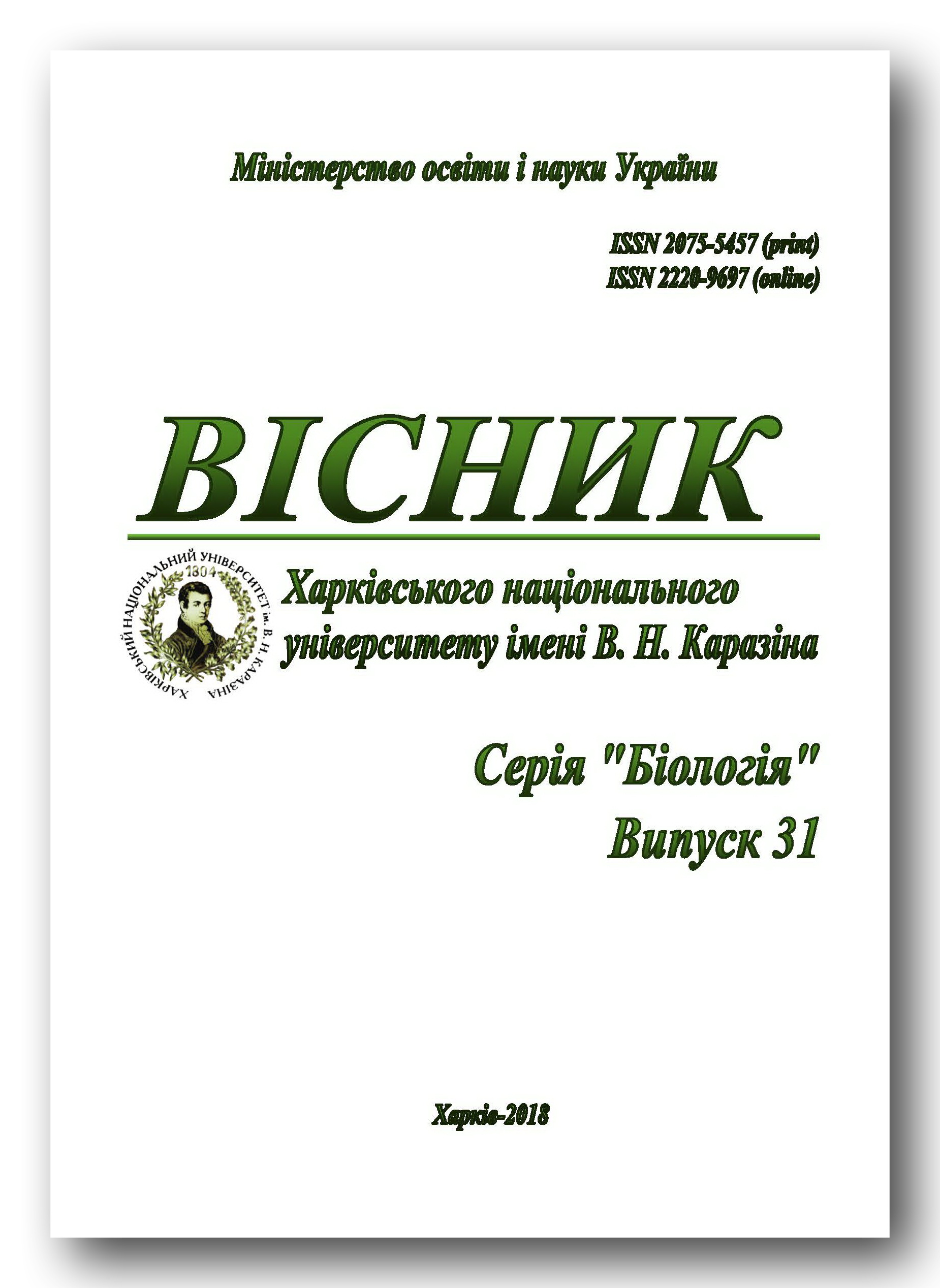Macrophytobenthos of artificial ponds in the parks of Odessa city
Abstract
Complex eco-floristic investigation of water vegetation of the artificial ponds in the park zones of Odessa city has not been conducted. Thus, the purpose of this work was determination of species diversity of macrophytes, their systematic structure and indicator role in four ponds in the park of the city. In sum, 21 species of macrophytes were identified, among them 15 species of macrophyte algae and 6 species of vascular water plants. The main part of the revealed species of macrophyte algae belongs to Chlorophyta (8) and Charophyta (4). Cyanoprocaryota were presented by 2 species, and Ochrophyta (Xanthophyceae) were presented by 1 species. 6 widely distributed species were revealed among higher water plants. Composition and distribution of macrophytes in the investigated ponds were influenced primarily by the level of water mineralization, eutrophication and heavy metals contamination. Elevated concentration of organic Carbon was registered in the ponds where waterfowl birds were presented together with water plants. The biggest floristic diversity of macrophytes is registered in the upper pond of the Dyukovsky Park (17 species). It is one of the largest artificial ponds of the city. The characteristic feature of the pond’s vegetation is the presence of an extensive field of Charophyta with a monodominant Chara vulgaris. The presence of the Charophyta is the evidence of the relative ecologic well-being of the investigated pond. Charophyta, as well as the other algae, are obviously the main providers of organic Carbon in the pond (Corg.=1.38%). By the quantity of macrophytes species (10) the lower pond of the Dyukovsky Park is on the second place. The content of organic Carbon is the highest in this pond (Corg.=4.48%). Except for the water vegetation, a considerable contribution in this parameter is obviously made by the decorative ducks which are kept in the fenced off with a net part of the pond by the bank restaurant. The minimum number of species of algae and higher water plants is registered in the Savitsky Park (5) and the Victory Park (6). In the Savitsky Park the excessive biogenic substances cause massive development of meso-eutrophic species of macrophytes – Lemna minor which covers almost the entire surface of the pond and creates adverse light regime for the development of algae. In the water column only sparse specimens of green algae Scenedesmus quadricauda (Turpin) Brebisson and Desmidium sp. were registered. Among the bank of the pond intermitted thicket of Typha angustifolia and Persicaria hydropiper is located. Macrophytes are the primary producers of organic substances here (Corg.=1.94%). Indicator species of algae and higher water plants in the investigated ponds were presented mostly by β-mesosaprobic group. It is the evidence of the medium level of their organic contamination.
Downloads
References
Algae. Reference book / S.P.Vasser, N.V.Kondrat’eva, N.P.Masyuk et al. – Kiev: Nauk. dumka, 1989. – 606p. (in Ukrainian)
Diel I. Kluc na urcovanie vytrusnych rastlin. – Bratislava: Sloven. рedagog. naklad, 1975. – 396p.
Dubyna D.V., Geyny S., Groudova Z. et al. Macrophytes – indicators of changes of the environment. – Kiev: Nauk. dumka, 1993. – 433p. (in Russian)
Gerasimyuk V.P., Gerasimyuk N.V. Algae in the pond of the Victory arboretum in Odessa city (Ukraine) // IV International conference “Advances in modern algology”. – Kiev, 2012. – P. 72–73. (in Russian)
Gollerbakh M.M., Palamar-Mordvintseva G.M. Charophyte algae (Charophyta) / Ed. S.P.Vasser. – Kiev: Nauk. dumka, 1991. – 196p. (in Ukrainian)
Guiry M.D., Guiry G.M. AlgaeBase. World-wide electronic publication. – National University of Ireland, Galway, 2018. (http://www.algaebase.org)
Junger V.P., Moshkova N.O. Oedogonium algae – Oedogoniales / Executive editor S.P.Vasser. – Kiev: Nauk. dumka, 1993. – 412p. (in Ukrainian)
Kondrat’eva N.V. Blue-green algae – Cyanophyta. Part 2. Classis – Hormogoniophyceae / Ed. A.M.Oksner. – Kiev: Nauk. dumka, 1968. – 524p. (in Ukrainian)
Oksiyuk O.P., Davydov O.A., Karpezo U.I. Microphytobenthos as an indicator of the condition of water ecosystems // Hydrobiology Journal. – 2010. – Vol.46 (5). – P. 75–89. (in Russian)
Orlova O.I., Savel’eva E.I., Radilov A.S. et al. Application of biomonitoring for estimation of nature and severity of the impact of a chemical factor // Medicine of Labour and Industrial Ecology. – 2010. – Vol.12. – P. 28–33. (in Russian)
Otmakhov V.I. Method of estimation of ecological safety of a water pool by contamination of the bottom sediments // News of Tomsk Polytechnic University. – 2003. – Vol.306 (6). – P. 39–41. (in Russian)
Rundina L.O. Conjugates – Conjugatophyceae. Part 3. Zygnema algae – Zygnematales / Executive editor G.M.Palamar-Mordvintseva. – Kiev: Nauk. dumka, 1988. – 204p. (in Ukrainian)
Sherbak V.I., Semenyuk N.E. Application of phytomicroperiphyton for estimation of ecological condition of the antropogenically modified water ecosystems // Hydrobiology Journal. – 2011. – Vol.47 (2). – P. 27–42. (in Russian)
Shikhaleeva G.N., Ennan A.A., Babinets S.K., Chursina O.D. Impact of motor transport on the condition of the environment of the resort complex “Kuyalnik-Luzanovka” // Modern informational and innovation technologies on transport: Materials of International scientific and practical conference. – Kherson: Publishing office of Kherson State Marine Institute, 2009. – Vol.5. – P. 58–59. (in Russian)
Sidorenko M.V., Tkachenko F.P. Biomonitoring of toxicity of the bottom sediments in the artificial ponds in the parks of Odessa city // International conference of young scientists “Advances in botany and ecology”. – Kiev: Nauk. dumka, 2018. – P.56. (in Russian)
The key of higher plants of Ukraine / D.N.Dobrochayeva, M.I.Kotov, U.N.Prokudin et al. – Kiev: Nauk. dumka, 1987. – 546p. (in Russian)
Vinogradova K.L., Gollerbakh M.M., Zawer L.M., Sdobnikova N.V. Key for freshwater algae of the USSR. Green algae – Chlorophyta: Siphonocladophyceae, Siphonophyceae; red algae – Rhodophyta; brown algae – Phaeophyta. – Leningrad: Nauka, 1980. – Vol.13. – 248p. (in Russian)
Authors retain copyright of their work and grant the journal the right of its first publication under the terms of the Creative Commons Attribution License 4.0 International (CC BY 4.0), that allows others to share the work with an acknowledgement of the work's authorship.




